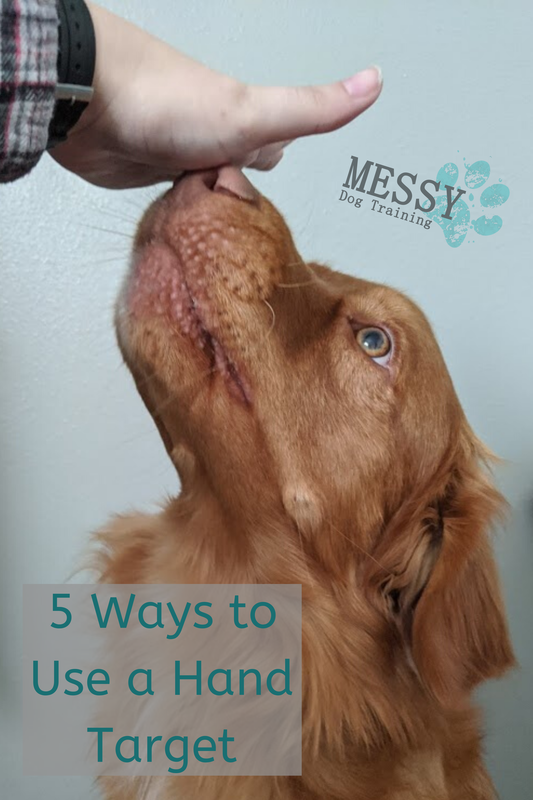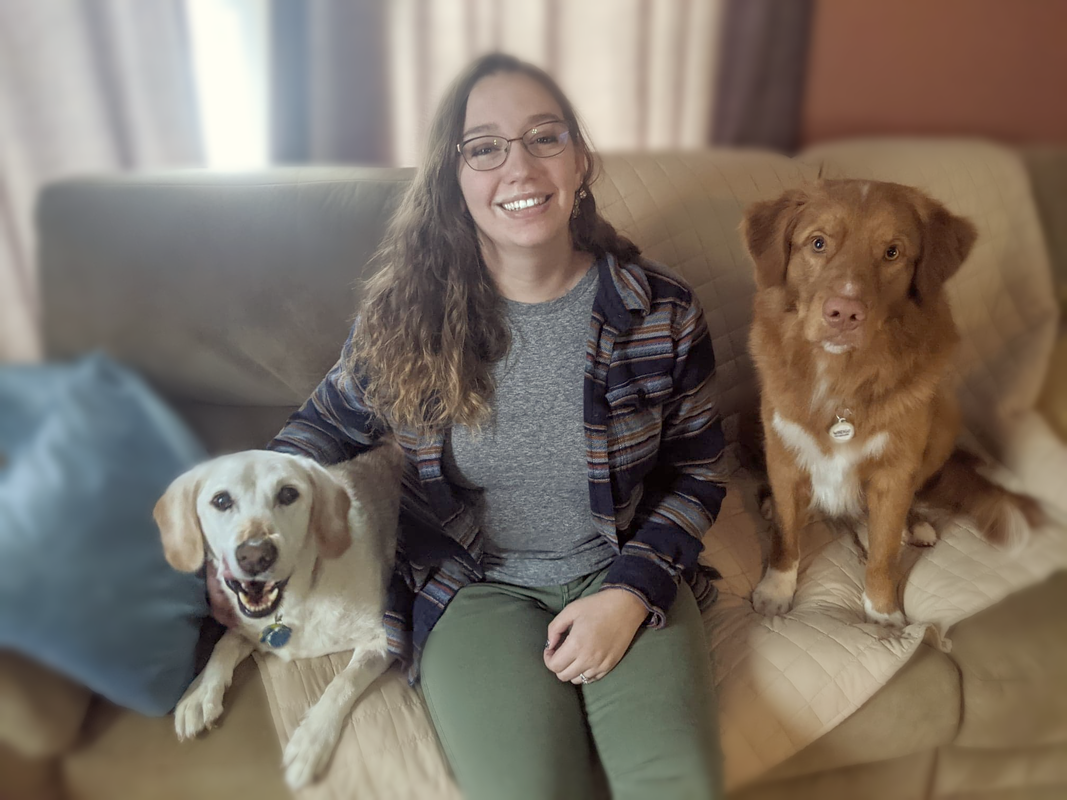|
We recently looked at how to teach a hand target to our dogs. Let's take a look at just some of the many ways we can use this useful behavior! If you haven't taught your dog a hand target yet, check out our recent how-to by visiting this blog post. 1. A way to cheat when calling your dog. Have you struggled to teach a recall to your dog? Does your dog sort of grasp the concept, but doesn’t come back within reach for you to actually grab them? A hand target can help solve these problems. The hand target gives dogs a nice, clear cue of what to do, rather than the sometimes ambiguous “come back in my vicinity, close enough for me to grab you” that we sometimes struggle to teach. When your dog touches their nose to your palm, you have the perfect opportunity to grab them with your other hand. A few cautions with hand targets and recalls - make sure you don’t over-use the behavior and make sure your dog is truly comfortable with being grabbed. If you always finish your recall hand targets by grabbing the collar of a dog who doesn’t like to be grabbed, you can “poison” your cue and your dog might start avoiding it, since they associate it with an aversive event. Avoid over-using it to the point that your dog starts to not want to respond to the cue. Just as with good recall training, we should ALWAYS make recalls to a hand target fun and exciting and rewarding if we want them to continue. 2. A way to move your dog around your home.
Maybe you struggle with getting your dog where you need them to be, whether it’s out of the way of the refrigerator door, or off of the bed when you’re trying to make it (or crawl under the covers yourself!). Once your dog has been taught a hand target, you can easily ask your dog to move out of your way in your home by having them target to the place you want them to be. It’s also extremely helpful for dogs who don’t understand “on” and “off” cues for furniture. Especially if your dog might be protective of the couch or bed, asking them to jump off and come touch your hand can reduce conflict. It’s never a good idea to try and force a growling or otherwise upset dog off of a piece of furniture, because there’s the possibility they’ll escalate their feelings to a bite. Utilizing a hand target takes away the stress of having a human forcibly moving you off of your comfy place! It’s also a way you can invite your dog up to snuggle and get them in a place on the couch that’s comfy for the both of you. 3. An easy way to teach loose leash walking! If your dog is tall enough to touch your hand while standing (or willing to bounce up to touch your hand) you can use it as an easy guide for loose leash walking! What I love about using the hand target for teaching your dog to walk on a loose leash is that it gives your dog a very specific place to be. In the beginning, you should be asking your dog to touch your hand often to keep them occupied and in place. From there, you should lengthen the time between hand touches. It’s also a wonderful way to guide your dog past something on your walk. If your dog normally has wonderful loose leash walking behavior, but there’s a distraction coming up that you know will be difficult for them, you can ask them to hand target past the distraction. This is another point where rapid hand targets can help instead of spaced out hand targets. 4. A simple way to occupy your dog during downtime. Let’s imagine that you ran into a friend that you haven’t seen for awhile when you are out walking your dog. Of course you want to stop and catch up! However, what’s your dog likely to do during this interaction? If you have a dog who can’t hold a stay in that situation, or a dog that is likely to be overly excited and want to jump on your friend, you can use hand targets to occupy your dog. I often utilize hand targets when I am giving a presentation or talk and my demo dog isn’t fully capable of sitting still for that long while I’m talking. The best way I’ve found to make use of hand targets in this situation is to have your dog target back and forth between both palms. Your dog gets to keep moving, which is helpful for excited or worried greeters to avoid the building stress that can happen when they are asked to sit still. Tossing them a reward every so often helps too - don’t just continue the behavior too long without a break or reward if your dog might become overly frustrated. 5. A way to prevent jumping. Dogs jump up on us because they have a desire to be closer to us, and especially to our faces. What if we could change that focus? We can shift their attention downwards, with the use of a hand target! If you’re trying to prevent jumping on yourself, just ask your dog to touch your hand (lowered at your side) instead when they approach you. You can then use this time to bend over, or ask for an alternate behavior, or even scatter feed. If you are consistent, you can make your hand target an easy alternative and default behavior for your dog to use when greeting you! If your goal is to prevent jumping on others, you can either instruct other people on how to greet your dog following the approach above, or you can take matters into your own training hands. Sometimes, it’s easiest to just work with your dog instead of trying to teach other people, too! In that case, you’ll want to watch your dog closely to know what behavior they display right before they jump on someone. If you suspect they might jump, just call your dog back to you with a hand target and release them back to greet. This helps take the pressure off of greetings for worried dogs, too, since they are given breaks in the greeting process and a way of leaving the person with minimal conflict. What ways will you start using hand targets with your own dogs?
0 Comments
Your comment will be posted after it is approved.
Leave a Reply. |
MESSY Dog Blog
What do you want your dog to do? We can help you train it! Categories
All
Archives
May 2020
|
Helping dogs and their owners achieve their goals since 2016
Currently serving owners in the Cedar Falls, IA area and online.
Currently serving owners in the Cedar Falls, IA area and online.


 RSS Feed
RSS Feed
